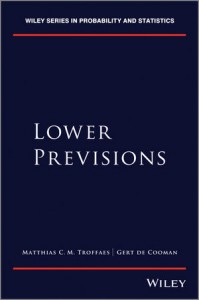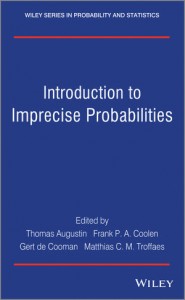Two New Books on Imprecise Probability Theories
Posted on July 17, 2014 by Matthias C. M. Troffaes[ go back to blog ]


The Books
Recently, two books have been published on imprecise probability theory:
- Lower Previsions: a monograph on said subject by myself and Gert de Cooman.
- Introduction to Imprecise Probabilities: a collection of contributed chapters on a wide range of topics, edited by Thomas Augustin, Frank Coolen, Gert de Cooman, and myself, with contributions from Joaquín Abellán, Alessandro Antonucci, Cassio P. de Campos, Giorgio Corani, Sébastien Destercke, Didier Dubois, Robert Hable, Filip Hermans, Nathan Huntley, Andrés Masegosa, Enrique Miranda, Serafín Moral, Michael Oberguggenberger, Erik Quaeghebeur, Glenn Shafer, Damjan Skulj, Michael Smithson, Lev Utkin, Gero Walter, Vladimir Vovk, Paolo Vicig, and Marco Zaffalon.
A monumental effort has gone into both publications. Summaries of their content, with tables of contents, can be found on Wiley’s website, linked above (just click on either title). Gert’s blog also replicates part of the preface of the lower previsions book. In this blog post here on the SIPTA site, I thought it would be useful to provide some insight into why these books have come about at all, why their publication is important, reflect back on how we eventually got there, and perhaps on what the next challenges might be.
But before I do that, I would like to express my enormous thanks to everyone who has supported these books, directly or indirectly, foremost my co-author Gert, co-editors Thomas and Frank, and all contributors named above, but also anyone who has helped the books along from the sidelines, our families, and many of our colleagues (in particular Teddy Seidenfeld), whose advice and help through the years have been invaluable.
Lower Previsions
If I want to go back as far as I can, the Lower Previsions book actually started around 2002, about a year after I started my PhD. Of course, initially, we had no clue yet a book was being conceived. It started with Gert giving me a “toy problem”: extend the theory of lower previsions to unbounded random variables. In the process of solving this problem, a report was written documenting various technical results. Unfortunately I no longer have an exact record of these early versions of the report. But in our paper, “Extension of coherent lower previsions to unbounded random variables” submitted to IPMU 2002, reference [3] says: “Gert de Cooman and Matthias Troffaes. Lower previsions for unbounded random variables. Book, in progress.” Apparently we got less ambitious shortly after. In September 2002, in a paper submitted to SPMS 2002, reference [4] says: “Gert de Cooman and Matthias C. M. Troffaes. Lower previsions for unbounded random variables. Tech. report, […], in progress.” However, the thought of writing a book was certainly there. As it goes, PhDs are full of distractions, which led to neither book nor report ever being published before the end of my PhD in 2005. Most of the material for the report simply ended up in some way as part of my PhD dissertation.
Around the time of my PhD defence, Gert strongly encouraged me to get my PhD out in book form, particularly the results on unbounded random variables. Leaving these results buried inside the PhD would have been a waste indeed. Moreover, we had many good ideas that we still wanted to explore. So, in July 2005, about a month after I arrived in the US for a year of post-doctoral research with Teddy Seidenfeld, I wrote to Gert (in Dutch, here translated to English):
Subject: hello […] Anyway, enjoy the vacation! In the mean time I am trying as soon as possible to get the book about unbounded gambles into an acceptable form. […]
I honestly did not quite think it would take nine more years. :-)
Since 2006, I have been keeping all my files under version control, and it is quite interesting, not to say even confrontational, to look at those early iterations of what was to become the lower previsions book. The earliest LaTeX files I have of the book date from February 22nd 2006: the book was 110 pages long, entitled “Lower previsions for unbounded random quantities”, and Chapters 4 and 5 already contained the core material for what is now in the second part of the book. In May of 2006, at Gert’s suggestion, we made the decision to split the book into two parts: one part based on bounded gambles (the theory initiated by Peter Williams and Peter Walley), and one part on extending the theory to unbounded gambles. This made for a more consistent and self-contained book.
The decision to split the book into two parts also opened up the avenue to discuss a very wide range of new developments in the theory. And so in the next 8 years, various interesting novel results taken from the literature were added as chapters to the first part—not just our own results, but any results that we deemed useful enough for a wide range of people. The first part of Lower Previsions thus became a reference work, giving a wide overview of the key contributions (many, but certainly not all!) to the existing mathematical theory of lower previsions, at least as far as the unconditional theory goes.
One might be tempted to ask whether part one replaces Walley’s 1991 book: it certainly does not. We give a more compact theoretical development of the theory of unconditional lower previsions, and build on that to discuss a wide range of newer developments. Whilst we do discuss some philosophical issues, this is not the focus of the book: Lower Previsions is mathematical monograph. In contrast, Walley’s book goes far deeper into philosophical issues.
Concerning the conditional theory—which we do in the second part when looking at unbounded random variables as well, we depart more clearly from Walley’s approach, instead following Williams’s ideas from the mid 70s. In fact, this also fits the mathematical nature of the work: Williams is not concerned with conglomerability. My personal opinion is that the theory without conglomerability is mathematically much nicer, and in fact, mathematically also more general, as Paolo Vicig always says. Moreover, for constructivists, conglomerability might not be as compelling anyway (this is precisely De Finetti’s objection).
Anyway, we kept adding and adding, and at some point in 2011, it was clear that we simply had to stop doing this if we wanted the book ever to be published. Incomplete chapters were cut, sometimes with pain and sadness. In particular, all reference to gauges were removed. (Gauges provide an elegant abstract way to derive many results quite quickly, however we never managed to introduce them in a way that truly felt right and elegant. Some day I hope to resurrect them.) The next two years were spent on careful reviewing and refining the material—over 400 pages—to perfection.
Introduction to Imprecise Probabilities
Introduction to Imprecise Probabilities, or more briefly, ITIP as we called it pretty much from day one, started in the pub. Frank had this brilliant idea, already for quite a while, that we should spread the imprecise message, and what was obviously missing was a good introductory text on imprecise probability. Yes, there was Walley’s Statistical Reasoning with Imprecise Probabilities, but already in 2009, Walley’s book was getting out of print, with no clear plans for a reprint or second edition despite high demand, essentially due to Peter Walley’s withdrawal from the research community. Yes, Frank knew that Gert and I were working on our book. However, it was also very clear to us that our book would not be appropriate as an introductory book to give to, say, a starting PhD student or interested researcher who is merely looking to have a broad understanding of the field, perhaps looking to apply imprecise probability in some of their research.
So, in Munich, at WPMSIIP 2009, Frank bought everybody a beer, and in a nutshell we all agreed that we would write a chapter. I still fondly recall the intoxicating cheers: “to the book!”. So, everybody got their act together—some authors considerably faster than others—and wrote a chapter.
By 2011, most of the writing was done. During 2012, the chapters were reviewed and revised. In 2013, Thomas and his team in Munich spent a lot of time on making the notation consistent across the entire book, fixing references and various other details. A final revision by the authors ensued, and then essentially the book was submitted.
Lessons Learnt
The experience in getting these two books written and published has been one with great satisfaction at the end, yet some bumps in the road that perhaps could have been avoided.
One bump, common to both books, are the copy-editing and proofing stages conducted with Wiley. For the Lower Previsions book, the copy-edits were provided directly in pdf format, and only after insisting, we were given the edited LaTeX files (actually, word files that contain LaTeX code). Some copy-edits in the pdf however were not marked in the LaTeX code. For ITIP, we simply went with the pdf as it concerned far less material per author and hence not worth the hassle.
This said, I found the Wiley folks very helpful and supportive. Their operations however are not entirely adapted to support very mathematical works, where you want to stick to LaTeX for as long as possible: it is really non-trivial to indicate how, for example, you need a mathematical formula to be fixed. After Wiley’s copy-edits and our corrections to their edits, the end result was probably slightly better.
The main problem was actually punctuation: their copy-editors had a very different way to go about punctuation, and changed commas in every few sentences. It is however very easy to change the meaning of something by changing punctuation. So you really have to be very careful in checking all edits rigorously. Usually they get it right, but too often they do not.
I am unsure as to how one can really avoid these publisher bumps. The LaTeX issue is a matter of communicating clearly your expectations—then still you have to be lucky that these expectations are communicated through to the right person. The copy-editing issue is very hard to avoid: it would be quite unlikely to have a copy-editor well versed in mathematics. Perhaps they could give better guidance on punctuation and other style matters, so the copy-editing is less intrusive.
Another issue is time. How do you actually finish the book in time? This was not as much an issue for ITIP: the scope of the book was well contained and did not change throughout the process. Yes, it was perhaps a bit later than we had foreseen, but not by five years. So, if at all possible, my strong recommendation would be to make sure that indeed the scope is clear and contained, and will remain so. For Lower Previsions, we decided to move direction a few times, sometimes quite drastically, at the expense of time. That said, I think we made the right decisions. Perhaps we could have taken them earlier.
Finally, a lesson learnt from ITIP: how to edit a volume with many contributors? If you want the volume to exhibit consistency, you really need someone to go over the entire thing and make relentless edits. This is not something, say, Wiley’s copy-editor can do, due to the highly specialized field. Frank, Gert, and myself, are eternally grateful to Thomas for having taken this tremendous task upon himself.
Acknowledgements
Thanks to Gert and Frank for proofreading this blog post.
